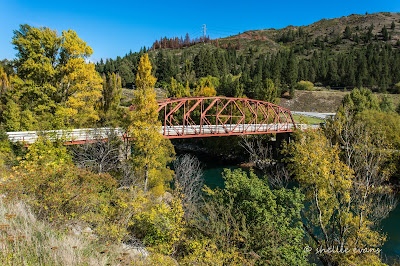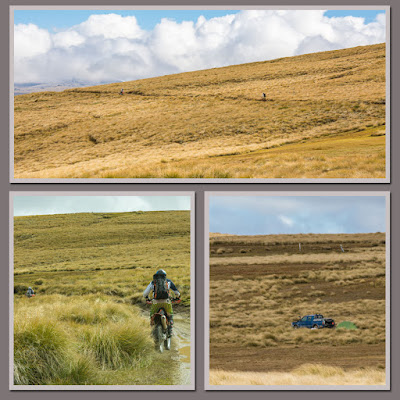Catch-up
After doing a few overdue chores in Alexandra (and staying at the NZMCA Molyneux Park for a couple of nights) we moved just 8 kilometres up the road to the lovely heritage township of Clyde for a few days...
 |
| Autumn in Clyde- Earnscleugh Bridge over the Clutha River |
...staying at a freedom camping area just above the Clyde Dam with this fabulous outlook.
The camping area is for CSC vehicles only and at the courtesy of the owner's, Contact Energy. That's the dam wall in the background.
I drove around to the lookout above the dam which is just off the the main road through the gorge. The dam lake stretches 20kms up through the gorge to Cromwell and is actually part of the manmade Lake Dunstan.
Before the Clutha River was dammed at Clyde, the land through the gorge and the area now occupied by Lake Dunstan in Cromwell was highly productive fruit orchards and farmland. Many of the orchards, much of the farmland along with buildings and infrastructure that weren't moved were drowned as the dam filled, and still lay beneath the lake.
This old photo (courtesy of Mighty Clutha- Otago's Stolen Treasure's blog) shows Fruitgrowers Road on the left (where we're now camped). My photos below this one show a similar perspective although from a little lower down. Leaning Rock is on the highest point ahead.
...to a quiet spot of fishing...
...and an even quieter spot of snoozing....(to be fair, he was actually reading his cellphone)
The peace was well and truly shattered when this guy roared away, Not only did the powerful jet blast through the stillness but the throbbing bass coming out of the sound system attached to the bimini cover could be heard above the roar as well. This boat with bling certainly turned a few heads in camp.
The sun dropped below the range behind us early, it was a long time afterwards before the clouds on the other side of the lake turned brilliant colours of yellow and orange.
While I was taking photos of the lake, David scanned the rocky valley and slopes behind us, we're always on the lookout for a stray deer or two although it's usually only goats we spot. This time he saw something that got us very excited.
A very big predator proof, fenced enclosure! A very well disguised fence too; if you look closely you can see it in the photo above, just in front of that middle pylon and then behind the pylon on the right (click photo to enlarge).
Wow! How cool is that, we wondered what it contained. I had this wild idea that we'd stumbled on an Otago Giant & Grand Skink enclosure, similar to the one went looking for at Macraes Flat last month.
The vehicle track carried on up the valley through the Aldinga Conservation Area but a locked gate blocked our way, a DOC sign indicated there was a 4km loop track we could walk. We set off hoping the track passed the fence somewhere along it's length.
Bright ribbons of yellow filled the small gullies, where willows thrive near the small streams that made there their way down to the dam.
It was hard to make out the fence on the landscape even as we got closer. In the end we decided to take a shortcut across the stream below us and straight up the hill...
...fighting our way through the prickly briar bushes and being careful not to break an ankle in one of the hundreds of rabbit holes that pitted the ground, to arrive right in front of the fence.
A predator proof fence that is indeed encloses a sanctuary for the Otago & Giant Skink; Mokomoko Dryland Sanctuary! And there's not only one enclosure but two; the first and smaller 0.3hectare one is on the right and was built to test whether protecting the lizards in this location would help increase their numbers. It did, so the larger 14 hectare enclosure surrounded by 1.6kms of fence was built on the left.
How amazing is that and we didn't even go looking for it (click to enlarge the photo of you'd like to read about the sanctuary).
The Maori name for the skinks is moko, the skinks skin patterns look much like the traditional Maori chin tattoos which are called moko. Here's one of my earlier photos from the Orokonui Sanctuary in Dunedin.
So close yet so far. In the smaller enclosure piles of corrugated iron were stacked at regular intervals on the rocks near the fence. Skinks would seek out the shelters and the warmth generated by the iron making it also a handy location for trust members to count them.
With no skinks to be seen we headed back to the ute. Can you spot it? (Click to enlarge and see the end of the blog if you have no luck)
We stopped at the dam wall on the way out.
Conroys Dam was built in 1935 across Conroys Gully and was built to store water for irrigation for the developing orchards in area. The dam is now a popular Brown Trout fishery and holds good quantities of koura (freshwater crayfish) too.
There's obviously been very little rainfall over summer, which isn't unusual for Central Otago but the lake level looked to be very low. Like nearby Butchers Dam I imagine Conroys would also be frozen solid over winter.
The narrow walkway over the dam is a little intimidating...
...with a high drop off down into the gully and stream on the other side. I can see why there are so many dams in Central, the narrow rocky gorges and gullies make it easier to dam.
We left the dam behind us and stopped at the irrigation ponds alongside the road on the way out.
The ponds are fed by a small water canal that leaves the dam here (but not for much longer if there's no rain coming soon)...
And just below the ponds is the first orchard that benefits from the water supply. Most of the trees look to be apricot and cherry and of course they are well finished for the season...
...unlike the gorgeous fig tree I found being stripped by birds back in Clyde. I managed to rescue a few juicy figs for myself (like how I changed the subject ever so subtly?). After feijoas, these are my next best favourite autumn fruit...I later saw figs in a local supermarket at $30kg! I can tell you I savoured every single one of them.
And the location? Click to enlarge...





















































